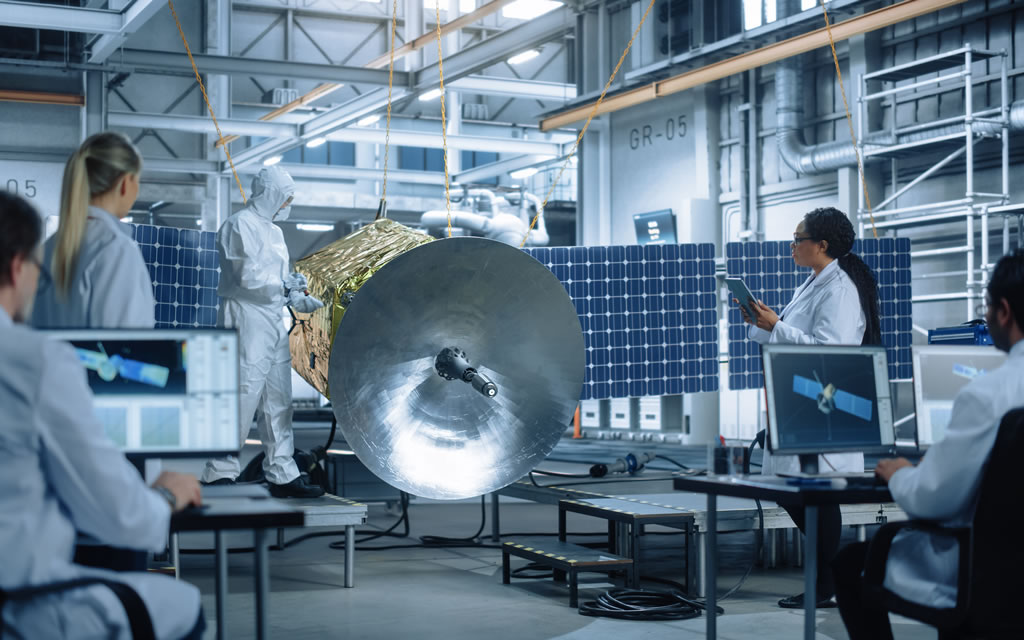Space engineering is a growing field that will only continue to expand in the coming years. Space engineers design spacecraft, satellites, and other space-based systems. The need for space engineers is increasing as more companies, entrepreneurs, governments,, and research agencies look for people with specialized knowledge in designing space technologies. Those who have studied space engineering have a variety of exciting career options after graduation.
What is Space Engineering?
Space engineering is a broad field that applies physics and engineering principles to design spacecraft, satellites, and related systems in outer space. These specially designed pieces of technology are then deployed either within the Earth’s orbit or to other parts of the solar system. Spacecraft design, along with the engineering to launch, control, and operate them, is a major part of space engineering. Other areas of focus may include resource management, human health, or the impact of space on other systems on Earth.
History of Space Engineering
The history of space engineering can be traced back to the early days of human exploration. Yuri Gagarin achieved the first human spaceflight in 1961; he was the first person to travel into space. This achievement intensified interest in space exploration and inspired a number of world leaders to push their governments toward the stars.
The Soviet Union achieved the first successful orbital flight in the 1960s with their Vostok 1 spacecraft. This spacecraft was launched on a Soyuz rocket and successfully docked with the Mir space station. The Vostok 1 spacecraft was the first to carry a crew into orbit and was also the first to carry an automated docking system. The Vostok 1 spacecraft also carried out a number of scientific experiments, including a radio telescope and a communications system.
The United States achieved the first successful manned orbital flight with its Apollo 8 spacecraft. This spacecraft was launched on a Saturn V rocket and successfully docked with the Apollo 8 spacecraft. The Apollo 8 spacecraft carried a crew of three astronauts, including Neil Armstrong, who became the first person to walk on the moon. The Apollo 8 spacecraft also conducted several scientific experiments, including an ultraviolet camera and a laser communication system.
Space Engineering Categories
The field of space engineering is a broad field that can be broken down into two categories, aeronautical and astronautical engineering. These categories may overlap, but each has a unique set of sub-disciplines.
Aeronautical engineering involves designing and building aircraft and includes disciplines like mechanics, materials science, and avionics. The aviation industry is one of the most well-understood fields of engineering.
Astronautical engineering is related to designing, building, and operating spacecraft. Astronauts, the astronauts who travel on space missions, are trained in astronautical engineering.
Job Duties of a Space Engineer
A space engineer designs, builds, and operates spacecraft and other space-based systems. This can include designing and building the spacecraft, designing the mission, creating and implementing ground control procedures, operating and maintaining the spacecraft, and managing operations.
They are also responsible for creating the technology that allows these devices to function and communicate with one another. They also have to be able to troubleshoot problems that may arise during the construction process.
Famous Space Engineering Innovations
Viking 1 – The first successful attempt at a Mars lander by the United States was the Viking 1 mission, which successfully landed a probe on the Martian surface in 1976. The lander transmitted back data that helped scientists understand the Martian surface, including the presence of methane, iron, and nitrogen.
The Hubble Space Telescope – The Hubble Space Telescope has been in orbit since 1990. Its view of the universe and its ability to provide scientists with data has helped advance the study of astronomy, astrophysics, cosmology, and physics.
Cassini-Huygens Mission – The Cassini-Huygens mission was a collaborative effort between NASA and the European Space Agency. It was specifically designed to study the geology and atmosphere of Saturn.
How to Start a Career in Space Engineering
Many different career paths are available for those interested in working in the space industry. Some of the most common options include aerospace engineers, space scientists, space engineers, and space program managers. You may be better suited to one of these fields depending on your background and interests.
The first step in getting into the field is to get a degree in engineering or a related field. After you’ve completed your degree, you’ll need to get some experience under your belt. This can be done by working in a lab or by interning at a company.
Once you’ve gained experience, you can start looking for a job. This can be done by sending out resumes or by networking with people in the industry. Once you’ve found a job, you’ll need to prepare for your interview. This can be done by preparing for the interview with research papers or by attending conferences and networking with people in the industry.
The future of space exploration will see us traveling to other planets and exploring the universe. To do this, we will need to design, build and test new technologies that are safe and efficient. Space engineers are at the heart of this exploration, designing, building, and testing new technologies that will allow us to travel to other planets, explore the universe, and even visit other stars. Now that you know what space engineering is and why you should study it, you are ready to start. Space engineering is a fascinating field that has huge potential for growth in the near future.
- Aerospace Engineers
- Development in Space Technology
- Careers in Space Engineering
- Aerospace Engineering Jobs in the United States
- Aerospace History Timeline
- The Evolution of Aerospace Engineering
- Average Aeronautical Engineer Salary
- Aerospace Job Description
- Career in Space
- Inventions in the Field of Space Engineering
- Aerospace Engineer: A Complete Career Guide
- Viking: 1st Lander on Mars
- Cassini-Huygens Mission
- The Future of Spaceflight
- The Future of Space Exploration
